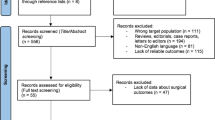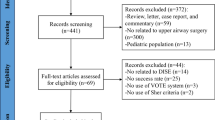Abstract
Background
Obstructive sleep apnea (OSA) is becoming increasingly more prevalent with the rise in obesity. Complications from gastrointestinal (GI) endoscopy in this patient population have been reported in several studies, but the modest complication rates from these procedures make it difficult to come to definitive conclusions based on single studies. The objective of our study was to systematically review these studies reporting the incidence of post-procedure complications in patients with OSA undergoing endoscopy to determine whether the presence of OSA increases post-procedure complications.
Methods
We conducted a systematic review using the Cochrane Collaboration Methodology. We searched Medline via Ovid, PubMed, Embase, and Evidence Based Medicine Reviews databases from 1950 to August 2013. We rated the quality of evidence for each outcome using the Grading of Recommendations Assessment, Development, and Evaluation (GRADE) methodology. Meta-analysis was done using Review Manager Version 5.0.20.
Results
Our search resulted in seven eligible studies. There was no significant association between diagnosis of OSA and post-GI endoscopy complications including hypoxemia, respiratory distress, variations in blood pressure or heart rate, bradypnea, or need for significant interventions. Subgroup analysis based on the type of GI endoscopy or the type of anesthesia used did not show any significant associations either.
Conclusions
Obstructive sleep apnea patients and/or patients at high risk for obstructive sleep apnea do not appear to be at increased risk of adverse outcomes from GI endoscopy.











Similar content being viewed by others
References
Peppard P, Young T, Barnet J, Palta M, Hagen E, Hla K (2013) Increased prevalence of sleep-disordered breathing in adults. Am J Epidemiol 177:1006–1014
Vasu TS, Grewal R, Doghramji K (2012) Obstructive sleep apnea syndrome and perioperative complications: a systematic review of the literature. J Clin Sleep Med 8(2):199–207
Gaddam S, Gunukula SK, Mador JM (2014) Post-operative outcomes in adult obstructive sleep apnea patients undergoing non-upper airway surgery: a systematic review and meta-analysis. Sleep Breath 18:615–633
Bailey PL, Pace NL, Ashburn MA, Moll JW, East KA, Stanley TH (1990) Frequent hypoxemia and apnea after sedation with midazolam and fentanyl. Anesthesiology 73(5):826–830
Eastwood PR, Platt PR, Shephard K, Maddison K, Hillman DR (2005) Collapsibility of the upper airway at different concentrations of propofol anesthesia. Anesthesiology 103:470–477
Mador MJ (2012) Do patients at risk of sleep apnea have an increased risk of cardio-respiratory complications during endoscopy procedures? Sleep Breath 16(3):609–615
Adler DG, Kawa C, Hilden K, Fang J (2011) Nurse-administered propofol sedation is safe for patients with obstructive sleep apnea undergoing routine endoscopy: a pilot study. Dig Dis Sci 56(9):2666–2671
Corso RM, Piraccini E, Agnoletti V, Lippi M, Buccioli M, Negro A et al (2012) Clinical use of the STOP-BANG questionnaire in patients undergoing sedation for endoscopic procedures. Minerva Anestesiol 78(1):109–110
Cote GA, Hovis CE, Hovis RM, Waldbaum L, Early DS, Edmundowicz SA et al (2010) A screening instrument for sleep apnea predicts airway maneuvers in patients undergoing advanced endoscopic procedures. Clin Gastroenterol Hepatol 8(8):660–665
Gill J, Vidyarthi G, Kulkarni P, Anderson W, Boyd W (2011) Safety of conscious sedation in patients with sleep apnea in a veteran population. South Med J 104(3):185–188
Khiani VS, Salah W, Maimone S, Cummings L, Chak A (2009) Sedation during endoscopy for patients at risk of obstructive sleep apnea. Gastrointest Endosc 70(6):1116–1120
Mador MJ, Abo Khamis M, Nag N, Mreyoud A, Jallu S, Mehboob S (2011) Does sleep apnea increase the risk of cardiorespiratory complications during endoscopy procedures? Sleep Breath 15(3):393–401
Crantock L, Cowen AE, Ward M, Roberts RK (1992) Supplemental low flow oxygen prevents hypoxia during endoscopic cholangiopancreatography. Gastrointest Endosc 38(4):418–420
Heuss LT, Schnieper P, Drewe J, Pflimlin E, Beglinger C (2003) Safety of propofol for conscious sedation during endoscopic procedures in high-risk patients—a prospective, controlled study. Am J Gastroenterol 98(8):1751–1757
Rozario L, Sloper D, Sheridan MJ (2008) Supplemental oxygen during moderate sedation and the occurrence of clinically significant desaturation during endoscopic procedures. Gastroenterol Nurs 31(4):281–285
Sharma VK, Nguyen CC, Crowell MD, Lieberman DA, de Garmo P, Fleischer DE (2007) A national study of cardiopulmonary unplanned events after GI endoscopy. Gastrointest Endosc 66(1):27–34
Vargo JJ (2010) Anesthesia-mediated sedation for advanced endoscopic procedures and cardiopulmonary complications: of mountains and molehills. Clin Gastroenterol Hepatol 8(2):103–104
Ravesloot MJL, de Vries N (2011) One hundred consecutive patients undergoing drug-induced sleep endoscopy: results and evaluation. Laryngoscope 121(12):2710–2716
Finkel KJ, Searleman AC, Tymkew H, Tanaka CY, Saager L, Safer-Zadeh E et al (2009) Prevalence of undiagnosed obstructive sleep apnea among adult surgical patients in an academic medical center. Sleep Med 10(7):753–758
Abrishami A, Khajehdehi A, Chung F (2010) A systematic review of screening questionnaires for obstructive sleep apnea. Can J Anaesth 57(5):423–438
Atkins D, Best D, Briss PA, Eccles M, Falck-Ytter Y, Flottorp S et al (2004) Grading quality of evidence and strength of recommendations. BMJ 328(7454):1490
Wani S, Azar R, Hovis CE, Hovis RM, Cote GA, Hall M et al (2011) Obesity as a risk factor for sedation-related complications during propofol-mediated sedation for advanced endoscopic procedures. Gastrointest Endosc 74(6):1238–1247
Chung F, Yegneswaran B, Liao P, Chung SA, Vairavanathan S, Islam S, Khajehdehl A, Shapiro CM (2008) Stop questionnaire. A tool to screen patients for obstructive sleep apnea. Anesthesiology 108:812–821
Chung F, Yegneswaran B, Liao P, Chung SA, Vairavanathan S, Islam S, Khajehdehl A, Shapiro CM (2008) Validation of the berlin questionnaire and American society of anesthesiologists checklist as screening tools for obstructive sleep apnea in surgical patients. Anesthesiology 108:822–830
Cappell MS (2010) Problems with combining esophagogastroduodenoscopy and colonoscopy to analyze risks of transient hypoxia from procedures in patients with risk factors for obstructive sleep apnea: a call for stratifying risks according to individual procedures. Gastrointest Endosc 72:672–673
Chung SA, Yuan H, Chung F (2008) A systematic review of obstructive sleep apnea and its implications for anesthesiologists. Anesth Analg 107:1543–1563
Ankichetty S, Wong J, Chung F (2011) A systematic review of the effects of sedatives and anesthetics in patients with obstructive sleep apnea. J Anaesthesiol Clin Pharmacol 27:447–458
Cacho G, Perez-Calle JL, Barbado A, Lledo JL, Ojea R, Fernandez-Rodriguez CM (2010) Capnography is superior to pulse oximetry for the detection of respiratory depression during colonoscopy. Rev Esp Enferm Dig Organo Oficial Soc Esp Patol Dig 102(2):86–89
Qadeer MA, Vargo JJ, Dumot JA, Lopez R, Trolli PA, Stevens T et al (2009) Capnographic monitoring of respiratory activity improves safety of sedation for endoscopic cholangiopancreatography and ultrasonography. Gastroenterology 136(5):1568–1576
Farney RJ, Walker BS, Farney RM, Snow GL, Walker JM (2011) The STOP-Bang equivalent model and prediction of severity of obstructive sleep apnea: relation to polysomnographic measurements of the apnea/hypopnea index. J Clin Sleep Med 7:459–465
Conflict of interest
The authors of the study have no conflicts of interest to declare.
Financial disclosures
None
Author information
Authors and Affiliations
Corresponding author
Appendix 1: Search terms used
Appendix 1: Search terms used
Apnea, complications, endoscopy, post-endoscopy complications, procedures, sleep, sleep apnea, sleep apnea syndrome, obstructive sleep apnea
Rights and permissions
About this article
Cite this article
Gaddam, S., Gunukula, S.K. & Mador, M.J. Post-gastrointestinal endoscopy complications in patients with obstructive sleep apnea or at high risk for sleep apnea: a systematic review and meta-analysis. Sleep Breath 20, 155–166 (2016). https://doi.org/10.1007/s11325-015-1199-6
Received:
Revised:
Accepted:
Published:
Issue Date:
DOI: https://doi.org/10.1007/s11325-015-1199-6




